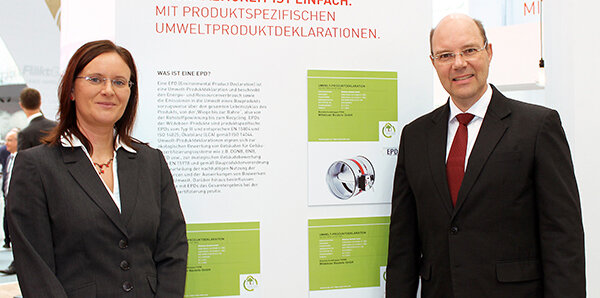At ISH in Frankfurt on 11 March Wildeboer Bauteile GmbH received three environmental product declarations for fire dampers from the Institute for Construction and Environment (Institut Bauen und Umwelt e.V.) – it was, in fact, the second time already, as the company from the East Frisian town of Weener has updated its existing declarations and had them verified again.
It has been more than five years now since Wildeboer created Environmental Product Declarations (EPD) for three fire dampers. These were then subsequently published by the Institute for Construction and Environment (IBU) in November 2013. As a result, Wildeboer was not only the first company from the field of technical building services to take part in the EPD programme of the IBU, but also the first company in the world to provide life-cycle assessment data for components for ventilation and air conditioning.
Pioneer in the technical building services sector
According to IBU Managing Director, Dr Alexander Röder, there is still far too little life cycle assessment data available, in particular from technical building services, although this field has a significant influence on the environmental impact of a building whilst it is in use. "That's why we are particularly pleased that Wildeboer has not only taken on a pioneering role, but has made sure that the data remains available and up-to-date", Röder reports.
An EPD loses its validity after five years. It has to be checked to make sure that the data content is current and correct, it then has to be updated as necessary and verified by independent experts in order to further qualify for publication by the IBU. Dr Jana Panaskova, who is responsible for sustainability and energy management at Wildeboer, received the three newly issued EPDs for FK90, FR90 and FK90K fire dampers at ISH.
Complete product life cycle objectively represented
"Our products are particularly notable for their maintenance-free construction and their contribution to the energy efficiency of the building", Panaskova explains. "Given that EPDs represent the environmental impact of a product over its entire life cycle, we can use them to demonstrate exactly these product characteristics based on life cycle assessment data." At Wildeboer EPDs are now firmly integrated into the company, as Panaskova further reports: "Other than fire dampers, we have also compiled EPDs for smoke control dampers and for volume flow controllers."
Furthermore, all the EPDs from Wildeboer comply with the ECO Platform standard, the umbrella organisation for various national EPD programme operators in Europe, meaning that they are recognised and freely available for interested parties in many European countries. The underlying life cycle assessment data is also stored in the ÖKOBAUDAT online database of building materials of the Federal Institute for Research on Building, Urban Affairs and Spatial Development (BBSR), where it is also available for public access. Wildeboer thus makes an important contribution to sustainability because, this way, reliable environmental data is available to all parties involved in construction, for example for planning or assessing sustainable construction projects.
